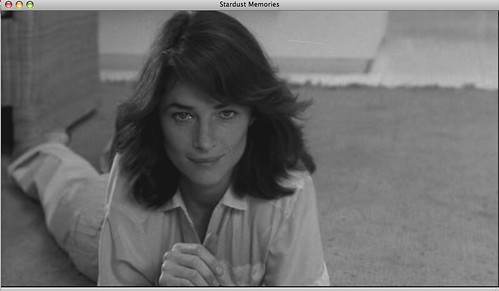 Woody Allen’s Stardust Memories is arguably his most poetic film overall, though other great classics of his, such as Another Woman and Interiors, also come close. It is interesting in reading some of the criticism regarding this film when it first came out, notably Roger Ebert who gave the film only two stars, believing it’s about a “filmmaker who is out of ideas.”
Woody Allen’s Stardust Memories is arguably his most poetic film overall, though other great classics of his, such as Another Woman and Interiors, also come close. It is interesting in reading some of the criticism regarding this film when it first came out, notably Roger Ebert who gave the film only two stars, believing it’s about a “filmmaker who is out of ideas.”Well, Ebert was wrong, for Stardust Memories is not only a great film, it is much more than that. Allen pays homage to one of his favorite directors, Federico Fellini, mirroring much of the opening on Fellini’s 8½. In the beginning, the filmmaker Sandy Bates (Allen) is being approached by fans much in the same way Marcello Mastroianni is in 8 ½ . The difference is, however, that Stardust Memories happens to be, overall, a better film. It’s much more concise and trimmed (finishing at around 90 minutes, as opposed to the more bloated parts to 8 ½) and Allen also maximizes his use of humor in this film, for while Stardust Memories offers a deeper exploration, it is not without its comic touch.
 Bates is a filmmaker who feels he has lost the real meaning of his life. Fed up by critics telling him they want the same old humor he’s been giving them, he cannot detach himself from knowing there is so much pain and suffering in the world, and that he needs to do something about it. His emotionally high-maintenance girlfriend, Dorrie, is played by Charlotte Rampling, and she has spent her days being locked away in an insane asylum, though despite Bates knowing that Dorrie is not good for him, he loves her nonetheless.
Bates is a filmmaker who feels he has lost the real meaning of his life. Fed up by critics telling him they want the same old humor he’s been giving them, he cannot detach himself from knowing there is so much pain and suffering in the world, and that he needs to do something about it. His emotionally high-maintenance girlfriend, Dorrie, is played by Charlotte Rampling, and she has spent her days being locked away in an insane asylum, though despite Bates knowing that Dorrie is not good for him, he loves her nonetheless.There is a particularly funny scene with Bates’ friend, played by Tony Roberts, where the two men get to talking about Dorrie. Bates says something along the lines of, “Dorrie, she was great, wasn’t she?” Where Roberts replies, “Yes, she was great. For two days out of the month. The rest of the twenty-eight she was lost.” And then Bates responds, “Yeah, but what a two days.”
 He later meets a young violinist, played by Jessica Harper, who shares the same “lost” characteristics as that of the emotionally troubled Dorrie, and Bates takes an instant liking to her, over his current girlfriend, Isobel. (And Isobel is of course not plagued with many of the emotional problems as that of the many women Bates is attracted to, and this causes him to pull away).
He later meets a young violinist, played by Jessica Harper, who shares the same “lost” characteristics as that of the emotionally troubled Dorrie, and Bates takes an instant liking to her, over his current girlfriend, Isobel. (And Isobel is of course not plagued with many of the emotional problems as that of the many women Bates is attracted to, and this causes him to pull away).One of the most memorable scenes in the film is, in fact, when Bates gets visited by an alien spaceship, and the alien admits that despite having an IQ of 1600, that even he cannot see what Bates saw in Dorrie over an emotionally mature woman like Isobel. Then, when Bates asks the questions of how can he find meaning? How can he contribute more to the world? How can he make a difference? The alien brilliantly responds with, “You want to make a difference in the world? Tell funnier jokes.”
 It is a message one should not overlook, one that says to do what one does best. Stardust Memories is cinematically the most daring of all Allen’s films, for his use of black and white to reveal the break down of characters (such as Dorrie in the mental hospital when the quick cuts expose the breakdown in her psyche), and also the symbolism to tie the memories of his past together with that of his present.
It is a message one should not overlook, one that says to do what one does best. Stardust Memories is cinematically the most daring of all Allen’s films, for his use of black and white to reveal the break down of characters (such as Dorrie in the mental hospital when the quick cuts expose the breakdown in her psyche), and also the symbolism to tie the memories of his past together with that of his present.Even the large mural on the wall changes to reflect Bates’ current mood at the time. Ultimately, the film version of the film reveals a frustrated audience once again who does not understand the work that has been presented to them. This is just another ironic, and unexpected twist from everything that has preceded this point. Stardust Memories does what all great art does: it allows you to watch and rewatch, presenting something different and new each time. And that never gets old.
Dan's review of the film can be found here.